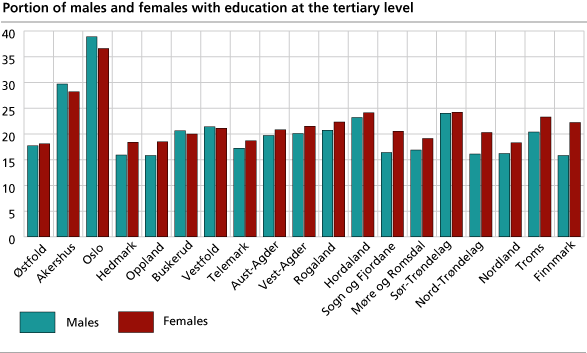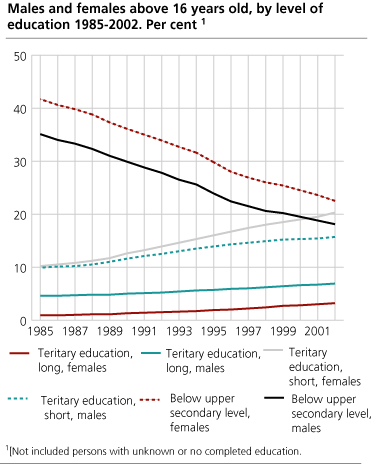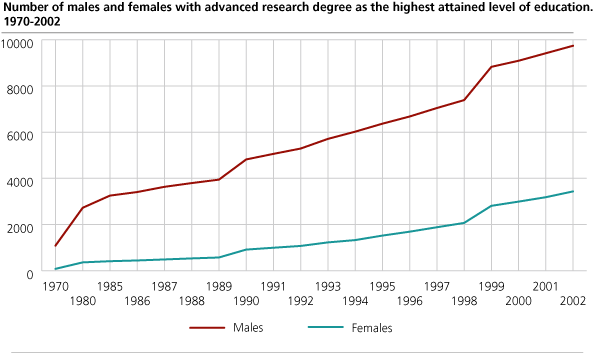Content
Published:
This is an archived release.
Most females with tertiary education
In 2002 a majority of the population in Norway, 16 years and above, who had attained any level of tertiary education were females Only four counties had a majority of men with tertiary education.
There were still more women than men who had attained a tertiary education with a duration of four years or less as the highest completed level of education, and most men who had attained a tertiary education lasting more than four years. On the other hand, the majority of those who had completed a tertiary education, irrespective of the level of the tertiary education, were women. In Norway, close to 24 per cent of women and 23 per cent of men had attained tertiary education.
Steady increase in the level of education
The attained level of education is still climbing in Norway, and the number of people with below upper secondary education decreases each year. In 1985 more than 38 per cent had attained below upper secondary level as their highest completed level of education. Ten years later the portion was about 27 per cent. In 2002, only 20 per cent of the Norwegian population had below upper secondary level, as their highest attained level. There were still more women then men who had attained this level of education, close to 23 per cent of the women and 18 per cent of the men in 2002.
Since 1985 more women than men have attained short tertiary education, a duration of four years or less. In 1985 there were 9.9 per cent men and 10.2 per cent women with this attained level of education. Ten years later the figures rose to 14 per cent men and 16 per cent women. In 2002 less than 16 per cent of the male population had attained short tertiary education, and about 20 per cent of the women.
Less than 1 per cent of women had completed a tertiary education lasting more than four years in 1985, just above 4 per cent of the men had attained the same level of education. In 1995 the portions had risen to 2 per cent women and 6 per cent men. In 2002 7 per cent of the men and approximately 3 per cent of the women had attained a long tertiary education.
Few elderly women with long tertiary education
The most significant differences in the level of education among the different age groups are naturally found among the elderly, since it lately has become more and more common for women to attend tertiary education. Less than 1 per cent of the women who are 67 years or older have completed a tertiary education lasting four years or longer. The corresponding figure for men at that age was more than 5 per cent. Within the age group 50-59 years, 6 percentage points more men than women have completed a long tertiary education. In the age group 25-29 years 14 percentage points more women then men have completed a short tertiary education. The majority of men holding a long tertiary education are 50-59 years, while the corresponding age group for women are 30-39 years.
12,000 more held an advanced degree in 2002 than in 1970
In 1970 approximately 1,200 of the Norwegian inhabitants had attained an advanced research degree as the highest level of education. 7 per cent of them were women. In 1980 close to 3,100 persons had completed this level, and the portion of women had risen to 12 per cent. Ten years later there were more than 5,700 who had completed an advanced research degree, of which 16 per cent women. In 2002 the figure was close to 13,200., and every fourth of these were women. The portion of the population with this level of education was 0.1 in 1970, and 0.4 per cent in 2002
The sharp increase in the number of inhabitants who have completed an advanced research degree in 1990 and 1999, as illustrated in Figure 3, is due to the collection of information collected by forms from Statistics Norway in 1990 and 1999. These forms were sent to the immigrant population in Norway where Statistics Norway did not have any registered information on the level of education. The forms were sent out as part of the Population and Housing Censuses in 1990 and 2001.
Tables:
- Table 1 Persons 16 years and above, by level of education, gender and county of residence. 1 October 2002
- Table 2 Persons 16 years and above by level of education and municipality of residence. 1 October 2002
- Table 3 Persons 16 years and above by highest attained level of education, gender and age. 1 October 2002. Per cent
- Table 4 Persons 16 years and above by highest attained level of education (level and field of education). 1 October 2002
Contact
-
Andrine Stengrundet
E-mail: andrine.stengrundet@ssb.no
tel.: (+47) 95 48 60 28
-
Anne Marie Rustad Holseter
E-mail: anne.marie.rustad.holseter@ssb.no
tel.: (+47) 93 45 98 35
-
Maj-Lisa Lervåg
E-mail: maj-lisa.lervag@ssb.no
tel.: (+47) 45 68 84 72



